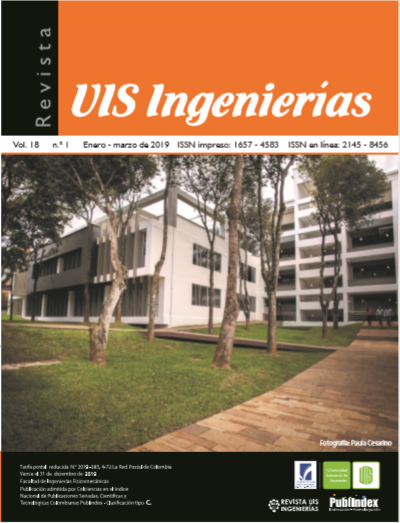Published 2019-01-01
Keywords
- energy,
- frequency,
- piezoelectric,
- transducer,
- transformation
How to Cite
Abstract
Working on alternatives for harnessing and transforming different forms of energy in a clean and efficient way, like piezoelectric phenomena, allows considering collecting energy that is commonly wasted. For example, the piezoelectricity facilitates the harvesting of energy derived from the weight discharged by humans when walking on a surface conditioned with piezoelectric transducers. However, the technology in this field has always advanced in the opposite direction, i.e. the conversion of electric energy into vibrations for different applications. In this work, the design of the material structure for a piezoelectric device of low resonance frequency for the capture of electricity is considered. The purpose of this device is the efficient transformation of mechanical energy into electrical energy; for this reason, the design of its configuration counts with a resonance frequency of less than 100 kHz. For this, the characteristics of the area dimensions and their relationship to the thickness according to the deposited material and the performance according to the projected impact were established. Moreover, the selection of the substrate was established according to the fracture requirements, acknowledging the mechanical loading loads of the transducer.
Downloads
References
PPA, “PPA Products Datasheet - User Manual,” 2017. [Online]. Available: https://info.mide.com/piezo-products/download-piezo-products-datasheets. [Accessed: Feb 02, 2017]
M. Takeuchi, H. Yamada, Y. Yoshino, T. Makino and S. Arai, “Effective electromechanical coupling coefficient (kt2) for fundamental mode of thickness extensional mode thin film bulk acoustic wave resonator fabricated by ZnO thin film,” Vacuum, vol. 66, no. 3-4, pp. 463-466, 2002. doi: 10.1016/S0042-207X(02)00116-1
Y. Q. Fu et al., “Advances in piezoelectric thin films for acoustic biosensors, acoustofluidics and lab-on-chip applications,” Prog. Mater. Sci., vol. 89, pp. 31–91, 2017. doi: 10.1016/j.pmatsci.2017.04.006
CTS Corporation (NYSE: CTS), “Piezoelectric Sense Products,” [Online]. Available: http://www.ctscorp.com/products/piezoelectric-products/. [Accessed: April 21, 2017].
P. Dineva, D. Gross, R. Müller, y T. Rangelov, Dynamic Fracture of Piezoelectric Materials, vol. 212. Cham: Springer International Publishing, 2014. doi: 10.1007/978-3-319-03961-9
P. P. Vergara-Barrios, J. M. Rey-López, G. A. Osma-Pinto and G. Ordóñez-Plata, “Evaluación del Potencial solar y eólico del campus central de la Universidad Industrial de Santander y la ciudad de Bucaramanga, Colombia,” Rev. UIS Ing., vol. 13, no. 2, pp. 49-57, 2014.
F. A. Pavas- Martinez, O. A. Gonzalez-Vivas and Y. S. Sanchez-Rosas, “Cuantificación del ahorro de energía eléctrica en clientes residenciales mediante acciones de gestión de demanda,” Rev. UIS Ing., vol. 12, no. 2, pp. 217-225, 2017. doi: 10.18273/revuin.v16n2-2017020
S. Han and C. Huh, “Analysis of a Piezoelectric Generator Under an Elastic Wave,” in IEEE Transactions on Plasma Science, vol. 45, no. 11, pp. 3001-3006, 2017. doi: 10.1109/TPS.2017.2752205
Y. Wang, L. Wang, T. Cheng, F. Qin and Z. Song, “Design and simulation analysis of a novel pneumatic-piezoelectric generator,” 2015 International Conference on Fluid Power and Mechatronics (FPM), Harbin, 2015, pp. 413-416. doi: 10.1109/FPM.2015.7337151
D. Grzybek, “Piezoelectric generator for the power supply of the monitoring system,” Proceedings of the 2014 15th International Carpathian Control Conference (ICCC), Velke Karlovice, 2014, pp. 135-138. doi: 10.1109/CarpathianCC.2014.6843584
S. Akkaya Oy and A. E. Özdemir, “Usage of piezoelectric material and generating electricity,” 2016 IEEE International Conference on Renewable Energy Research and Applications (ICRERA), Birmingham, 2016, pp. 63-66. doi: 10.1109/ICRERA.2016.7884363
D. Tibaduiza, M. Anaya, E. Forero, R. Castro, y F. Pozo, “A Sensor Fault Detection Methodology applied to Piezoelectric Active Systems in Structural Health Monitoring Applications”, IOP Conf. Ser. Mater. Sci. Eng., vol. 138, no. 1, p. 12016, 2016.
F. Lu, H. P. Lee and S. P. Lim, “Modeling and analysis of micro piezoelectric power generators for micro-electromechanical-systems applications,” Smart Mater. Struct., vol. 13, no. 1, pp. 57-63, 2004.
N. Ismall and R. A. Ghani, “Advance devices using piezoelectric harvesting energy,” 2013 IEEE Student Conference on Research and Developement, Putrajaya, 2013, pp. 450-453. doi: 10.1109/SCOReD.2013.7002629
J. Kang, J. Noh, Y. Oh, L. Hwang and J. Yoo, “Piezoelectric energy harvesting using lead-free (Na0.5K0.5)0.97(Nb0.96Sb0.04)O3 ceramics,” 2010 IEEE International Symposium on the Applications of Ferroelectrics (ISAF), Edinburgh, 2010, pp. 1-3. doi: 10.1109/ISAF.2010.5712221
M. Anwar, L. Hakim and N. Nadzri, “Prototype of a low power energy harvesting using piezoelectric transducer for common stationary workout,” 2017 IEEE 4th International Conference on Smart Instrumentation, Measurement and Application (ICSIMA), Putrajaya, 2017, pp. 1-4. doi: 10.1109/ICSIMA.2017.8312007.
D. Motter, J. V. Lavarda, F. A. Dias and S. S. da, “Vibration Energy Harvesting Using Piezoelectric Transducer and NonControlled Rectifiers Circuits,” J. Braz. Soc. Mech. Sci. & Eng., vol. 34, no. spe, pp. 378-385, 2012. doi: 10.1590/S1678-58782012000500006
A. Toprak y O. Tigli, “Piezoelectric energy harvesting: State-of-the-art and challenges,” Appl. Phys. Rev., vol. 1, no. 3, pp. 031104, 2014. doi: 10.1063/1.4896166
Yiming Liu, Geng Tian, Yong Wang, Junhong Lin, Qiming Zhang, y H. F. Hofmann, “Active Piezoelectric Energy Harvesting: General Principle and Experimental Demonstration”, J. Intell. Mater. Syst. Struct., vol. 20, no. 5, pp. 575–585, 2009. doi: 10.1177/1045389X08098195


